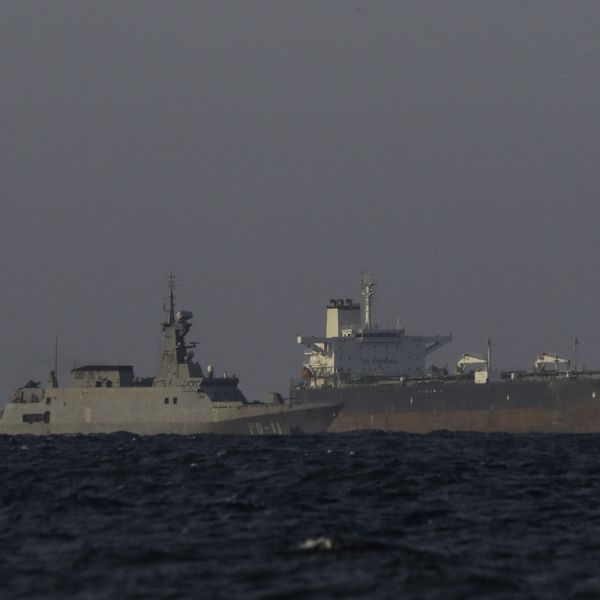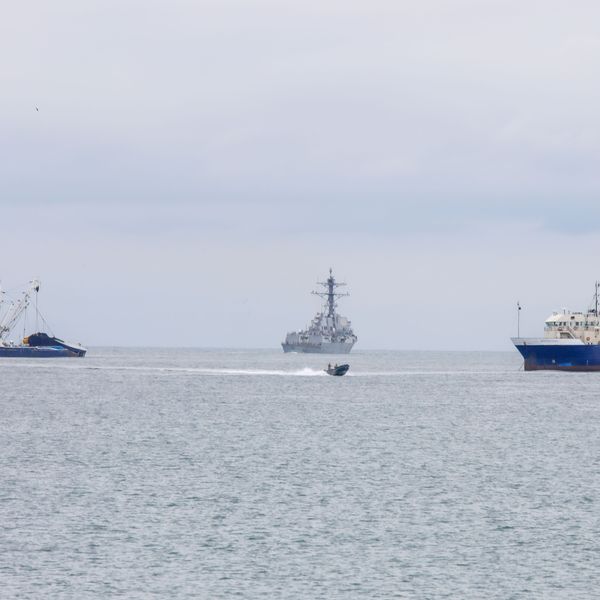US Positions Navy Warships Off North Korea in Advance of Rocket Launch
Pyongyang claims rocket will launch satellite by Dec. 22
The US is moving four Navy ships off the coast of North Korea after reports that the North Korean government will launch a ballistic missile sometime between December 10 and 22.
The US is also warning North Korea to cancel the launch--the country's second this year following a failed launch in April.
"It should seem logical that we'll move them around so we have the best situational awareness," Adm. Samuel Locklear, who commands US forces in the Asia-Pacific region, told a Pentagon news conference, Reuters reported. "To the degree that those ships are capable of participating in ballistic missile defense, then we will position them to be able to do that."
NBC News cites "officials" as saying that the Aegis guided-missle cruiser Shiloh and three guided-missile destroyers will be put in place as "a prudent precaution."
Locklear said the re-positioned US ships would answer a number of questions:
"If they do violate the Security Council and launch a missile, what kind is it? What is it about? Where does it go? Who does it threaten? Where do the parts of it ... that don't go where they want it to go, where do they go? And what are the consequences of that?" he said.
North Korea says the rocket will put a satellite into space, the BBC reports. The rocket is expected to fly south, with pieces dropping into the ocean west of Korea and then east of the Philippines. Parts of the rocket will fall near Japan's Okinawa prefecture, and the Japanese government has pledged to shoot down any debris that falls over its territory.
The BBC reports:
South Korea's Yonhap news agency--citing unidentified sources--reports that all three stages of the rocket are now in place at the launch site and that fuel is being injected into a storage tank, after which the rocket will be fuelled.
But a US think-tank says preparations may not be this far advanced, citing satellite images of the launch site.
The US and other governments say the launch would constitute a test of long-range missiles in violation of UN Security Council resolutions.
"We encourage the leadership in North Korea to consider what they are doing here and the implications on the overall security environment on the Korean Peninsula, as well as in Asia," Locklear said.
An Urgent Message From Our Co-Founder
Dear Common Dreams reader, The U.S. is on a fast track to authoritarianism like nothing I've ever seen. Meanwhile, corporate news outlets are utterly capitulating to Trump, twisting their coverage to avoid drawing his ire while lining up to stuff cash in his pockets. That's why I believe that Common Dreams is doing the best and most consequential reporting that we've ever done. Our small but mighty team is a progressive reporting powerhouse, covering the news every day that the corporate media never will. Our mission has always been simple: To inform. To inspire. And to ignite change for the common good. Now here's the key piece that I want all our readers to understand: None of this would be possible without your financial support. That's not just some fundraising cliche. It's the absolute and literal truth. We don't accept corporate advertising and never will. We don't have a paywall because we don't think people should be blocked from critical news based on their ability to pay. Everything we do is funded by the donations of readers like you. Will you donate now to help power the nonprofit, independent reporting of Common Dreams? Thank you for being a vital member of our community. Together, we can keep independent journalism alive when it’s needed most. - Craig Brown, Co-founder |
The US is moving four Navy ships off the coast of North Korea after reports that the North Korean government will launch a ballistic missile sometime between December 10 and 22.
The US is also warning North Korea to cancel the launch--the country's second this year following a failed launch in April.
"It should seem logical that we'll move them around so we have the best situational awareness," Adm. Samuel Locklear, who commands US forces in the Asia-Pacific region, told a Pentagon news conference, Reuters reported. "To the degree that those ships are capable of participating in ballistic missile defense, then we will position them to be able to do that."
NBC News cites "officials" as saying that the Aegis guided-missle cruiser Shiloh and three guided-missile destroyers will be put in place as "a prudent precaution."
Locklear said the re-positioned US ships would answer a number of questions:
"If they do violate the Security Council and launch a missile, what kind is it? What is it about? Where does it go? Who does it threaten? Where do the parts of it ... that don't go where they want it to go, where do they go? And what are the consequences of that?" he said.
North Korea says the rocket will put a satellite into space, the BBC reports. The rocket is expected to fly south, with pieces dropping into the ocean west of Korea and then east of the Philippines. Parts of the rocket will fall near Japan's Okinawa prefecture, and the Japanese government has pledged to shoot down any debris that falls over its territory.
The BBC reports:
South Korea's Yonhap news agency--citing unidentified sources--reports that all three stages of the rocket are now in place at the launch site and that fuel is being injected into a storage tank, after which the rocket will be fuelled.
But a US think-tank says preparations may not be this far advanced, citing satellite images of the launch site.
The US and other governments say the launch would constitute a test of long-range missiles in violation of UN Security Council resolutions.
"We encourage the leadership in North Korea to consider what they are doing here and the implications on the overall security environment on the Korean Peninsula, as well as in Asia," Locklear said.
The US is moving four Navy ships off the coast of North Korea after reports that the North Korean government will launch a ballistic missile sometime between December 10 and 22.
The US is also warning North Korea to cancel the launch--the country's second this year following a failed launch in April.
"It should seem logical that we'll move them around so we have the best situational awareness," Adm. Samuel Locklear, who commands US forces in the Asia-Pacific region, told a Pentagon news conference, Reuters reported. "To the degree that those ships are capable of participating in ballistic missile defense, then we will position them to be able to do that."
NBC News cites "officials" as saying that the Aegis guided-missle cruiser Shiloh and three guided-missile destroyers will be put in place as "a prudent precaution."
Locklear said the re-positioned US ships would answer a number of questions:
"If they do violate the Security Council and launch a missile, what kind is it? What is it about? Where does it go? Who does it threaten? Where do the parts of it ... that don't go where they want it to go, where do they go? And what are the consequences of that?" he said.
North Korea says the rocket will put a satellite into space, the BBC reports. The rocket is expected to fly south, with pieces dropping into the ocean west of Korea and then east of the Philippines. Parts of the rocket will fall near Japan's Okinawa prefecture, and the Japanese government has pledged to shoot down any debris that falls over its territory.
The BBC reports:
South Korea's Yonhap news agency--citing unidentified sources--reports that all three stages of the rocket are now in place at the launch site and that fuel is being injected into a storage tank, after which the rocket will be fuelled.
But a US think-tank says preparations may not be this far advanced, citing satellite images of the launch site.
The US and other governments say the launch would constitute a test of long-range missiles in violation of UN Security Council resolutions.
"We encourage the leadership in North Korea to consider what they are doing here and the implications on the overall security environment on the Korean Peninsula, as well as in Asia," Locklear said.

